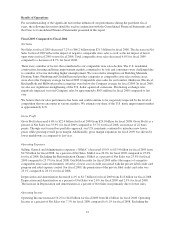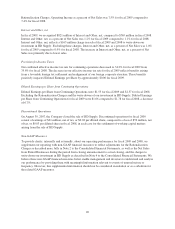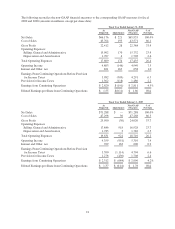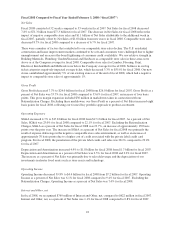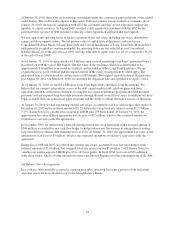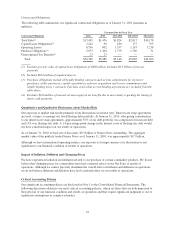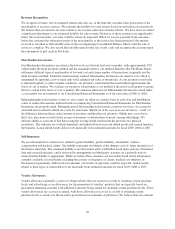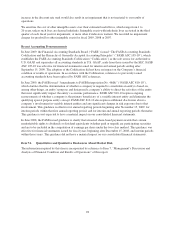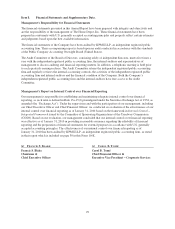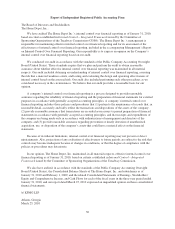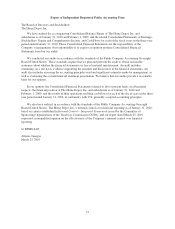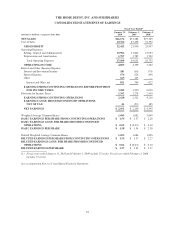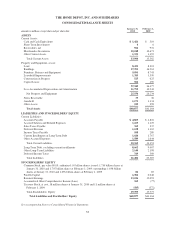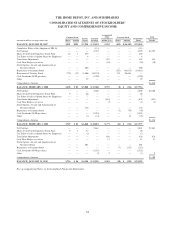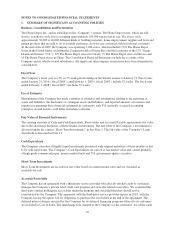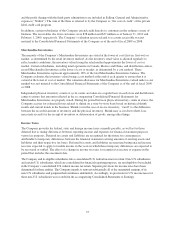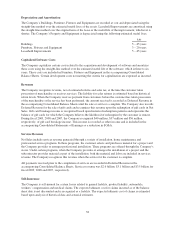Home Depot 2009 Annual Report Download - page 34
Download and view the complete annual report
Please find page 34 of the 2009 Home Depot annual report below. You can navigate through the pages in the report by either clicking on the pages listed below, or by using the keyword search tool below to find specific information within the annual report.
increase in the discount rate used would also result in an impairment that is not material to our results of
operations.
We amortize the cost of other intangible assets over their estimated useful lives, which range from 1 to
20 years, unless such lives are deemed indefinite. Intangible assets with indefinite lives are tested in the third
quarter of each fiscal year for impairment, or more often if indicators warrant. We recorded no impairment
charges for goodwill or other intangible assets for fiscal 2009, 2008 or 2007.
Recent Accounting Pronouncements
In June 2009, the Financial Accounting Standards Board (“FASB”) issued “The FASB Accounting Standards
Codification and the Hierarchy of Generally Accepted Accounting Principles” (“FASB ASC 105-10”), which
establishes the FASB Accounting Standards Codification (“Codification”) as the sole source for authoritative
U.S. GAAP and supersedes all accounting standards in U.S. GAAP, aside from those issued by the SEC. FASB
ASC 105-10 was effective for financial statements issued for interim and annual periods ending after
September 15, 2009. The adoption of the Codification did not have an impact on the Company’s financial
condition or results of operations. In accordance with the Codification, references to previously issued
accounting standards have been replaced by FASB ASC references.
In June 2009, the FASB issued “Amendments to FASB Interpretation No. 46(R)” (“FASB ASC 810-10”),
which clarifies that the determination of whether a company is required to consolidate an entity is based on,
among other things, an entity’s purpose and design and a company’s ability to direct the activities of the entity
that most significantly impact the entity’s economic performance. FASB ASC 810-10 requires ongoing
reassessments of whether a company is the primary beneficiary of a variable interest entity and eliminates the
qualifying special purpose entity concept. FASB ASC 810-10 also requires additional disclosures about a
company’s involvement in variable interest entities and any significant changes in risk exposure due to that
involvement. This guidance is effective for annual reporting periods beginning after November 15, 2009, for
interim periods within that first annual reporting period, and for interim and annual reporting periods thereafter.
This guidance is not expected to have a material impact on our consolidated financial statements.
In June 2008, the FASB issued guidance to clarify that unvested share-based payment awards that contain
nonforfeitable rights to dividends or dividend equivalents (whether paid or unpaid) are participating securities
and are to be included in the computation of earnings per share under the two-class method. This guidance was
effective for financial statements issued for fiscal years beginning after December 15, 2008, and interim periods
within those years. This guidance did not have a material impact on our consolidated financial statements.
Item 7A. Quantitative and Qualitative Disclosures About Market Risk.
The information required by this item is incorporated by reference to Item 7, “Management’s Discussion and
Analysis of Financial Condition and Results of Operations” of this report.
28



